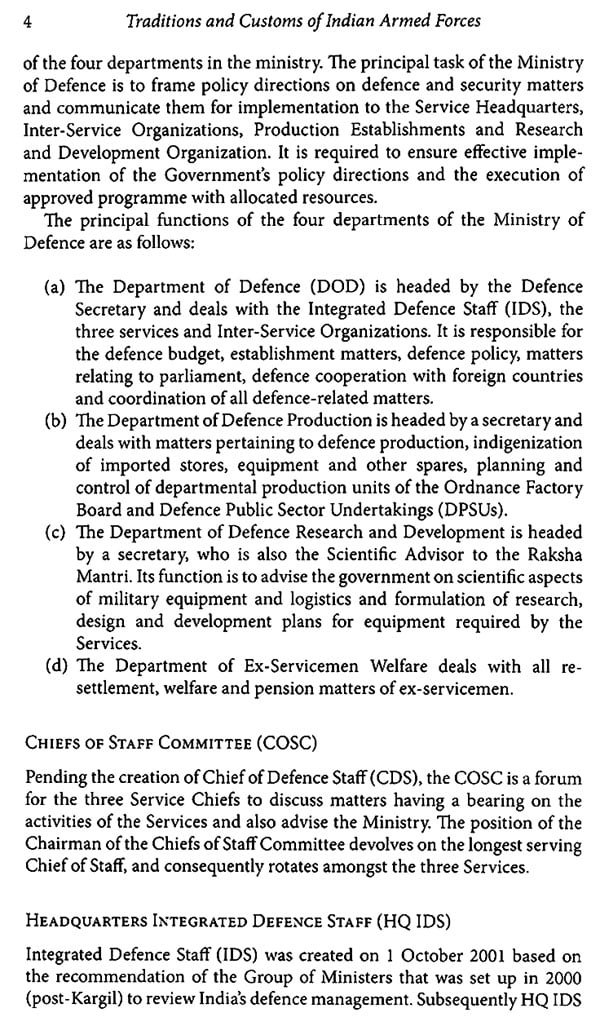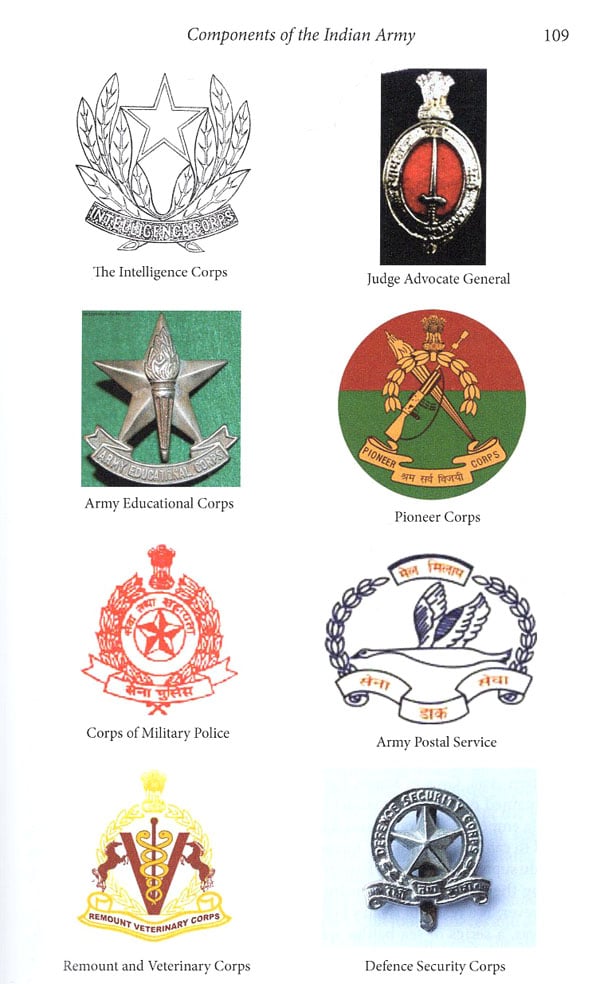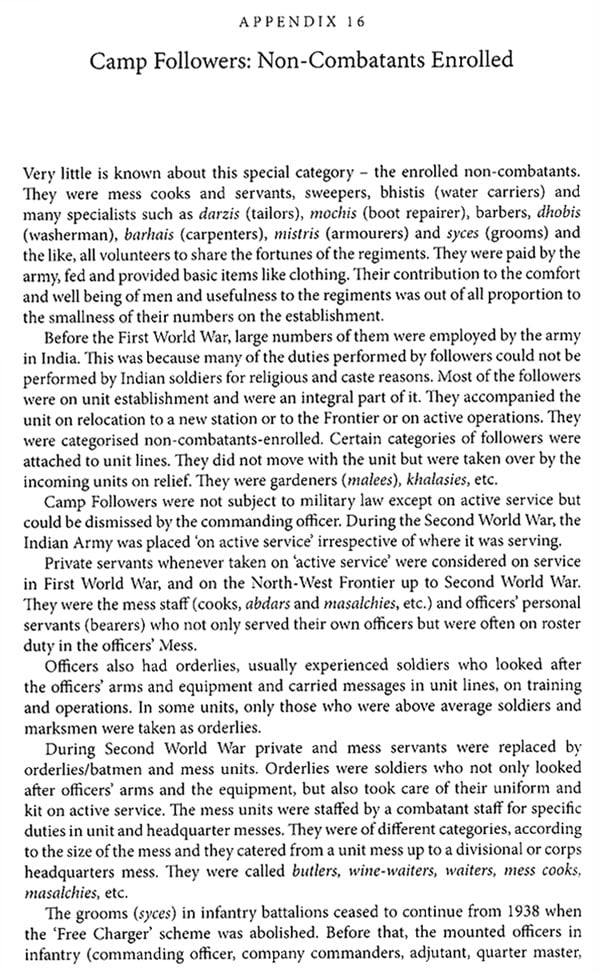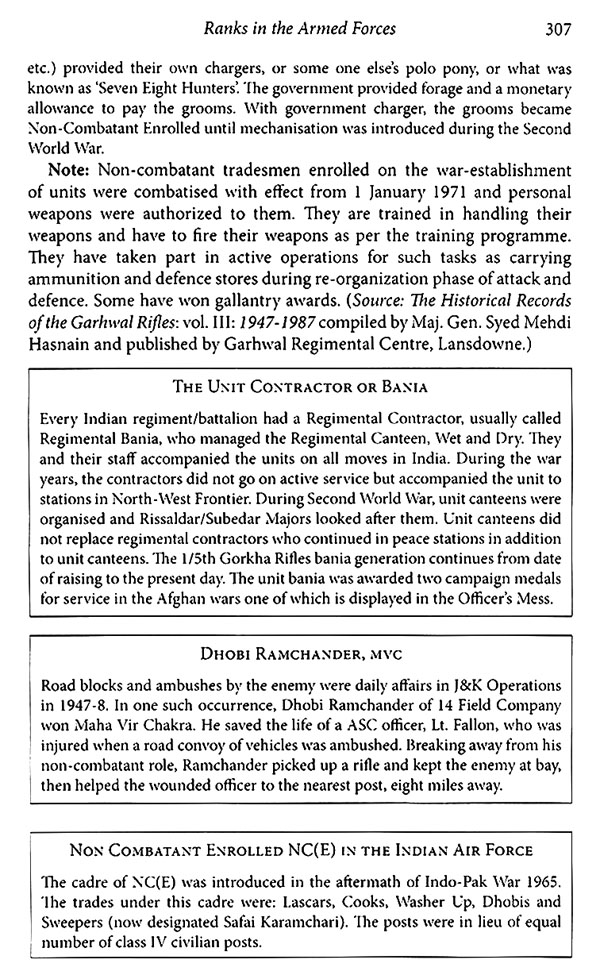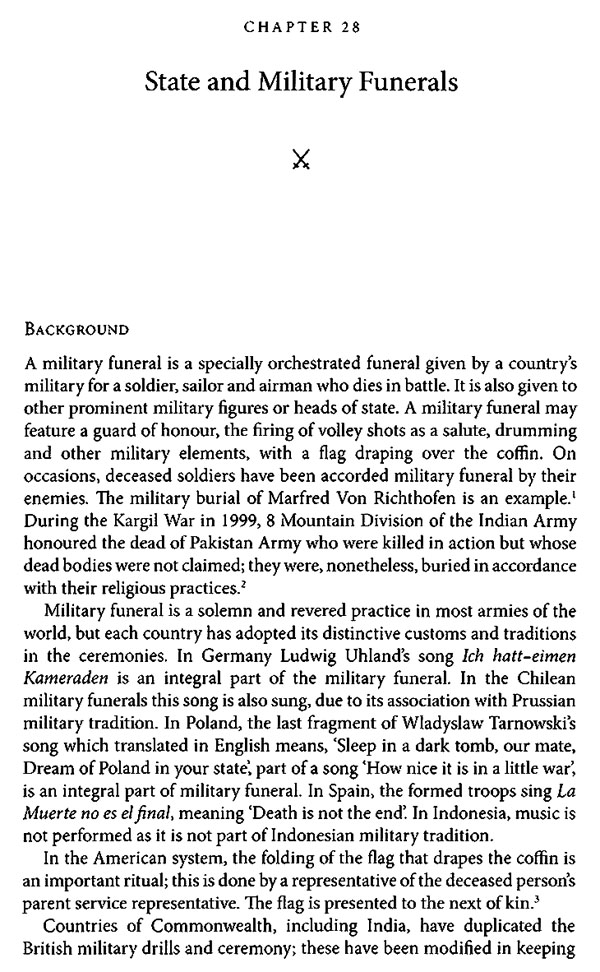
Traditions and Customs of the Indian Armed Forces
Book Specification
| Item Code: | NAZ360 |
| Author: | Brigadier S.P. Sinha |
| Publisher: | Manohar Publishers and Distributors |
| Language: | English |
| Edition: | 2021 |
| ISBN: | 9789390729029 |
| Pages: | 664 (Throughout Color Illustrations) |
| Cover: | HARDCOVER |
| Other Details | 9.50 X 6.50 inch |
| Weight | 1.30 kg |
Book Description
The foreword of the first edition of the book ‘Traditions and Customs of the Indian Armed Forces’ compiled by the late Major General Chand N Das was written by General TN Raina, MVC way back in 1984. Since then more than three decades have passed during which time our country and its armed forces have moved on to the new millennium. The revised edition has been undertaken at the express desire of the late author, who desired to see it brought up to date with the changing times. While the core military values of ‘Honour’, ‘Courage’ and ‘Never to Surrender’ remain steadfast, there are aspects of traditions and customs that change with the passage of time. A striking example is the induction of women officers and soldiers in the armed forces.
Military customs evolve over a period of time. During the colonial past, many military customs were designed to advance the imperial interests. After independence, our national and military symbols reflect the changed ethos and our civilisational heritage. Each Service has its own unique customs that contribute to build the ‘Espirit de Corps’ and in which every member takes immense pride. Military customs and practices have evolved as a consequence of long historical process. Many of these hark back to some event or experience of the past. To the uninitiated these may appear meaningless and anachronistic but they are effective tools to bond together individuals into a cohesive team. It is important that officers, soldiers, sailors and airmen know the traditions, customs and practices of their own Service as well as the other Services. It is all the more imperative today when most future military operations will be of a tri-service nature.
This revised edition has been edited and enlarged by Brigadier SP Sinha, VSM (Retired) who has added new chapters to make the book contemporary. The significance of crests, insignia, formation signs, flags, uniforms, dresses and rank badges have been explained along with their illustrations. This well-researched compilation fills the void in understanding the significance of the ceremonial and other practices in our armed forces. The book will be of interest for all service personnel and equally for anyone else interested in Service customs and etiquette, particularly the civil bureaucracy who can benefit from a better understanding of the ethos of the Services.
This book draws inspiration from the original written by Maj Gen. Chand N. Das that carried the same title but is not merely an edited and updated version of his book: it is a book with new themes and chapters that have been written to make them contemporary and contextual. I have written on themes that are in Chapter 2: Women Officers in the Armed Forces; Chapter 3: Civil-Military Relations; Chapter 4: Regimental System; Chapter 11: The Ethos; Chapter 21: Army Wives and Chapter 33: Other Practices.
The book, as the title suggests, is a compilation of customs and traditions in the Indian Armed Forces: the Indian Army, the Indian Navy and the Indian Air Force. Customs and traditions represent their ‘symbols and substance’ developed over a period of time and shape their institutional values; they are building blocks on which the foundation of esprit-de corps is built.
Most people talk of customs and traditions in the same breadth because the two words have interchangeable meaning. According to the Webster's Dictionary, custom is a habitual practice, the usual way of acting in given circumstances: Tradition on the other hand is beliefs, legends and customs handed down from generation to generation, especially by word of mouth or by practices. For example, in India it is customary to welcome foreign tourists by garlanding or applying tilak on their foreheads. Similarly, by tradition most Indians greet friends and acquaintances with namaste, bringing together both palms and holding them close to one’s chest.
So, what is the subtle difference between custom and tradition? In my understanding, while custom is the usual way of doing things in a group or society, tradition has a deeper meaning; something that impels a person or a group to perform in a particular way in a given situation. While both custom and tradition draw inspiration from the past, custom could be short lived or be observed only bya section of the society, tradition evolves over a much longer period, over centuries, and is observed by most people of a society and culture. Nonetheless, ‘while all traditions could qualify as customs, not all customs could be referred as tradition:
Military customs and traditions are unique in many ways. To the uninitiated military customs may appear meaningless or anachronistic but to those who understand their origin, they hark back to a past event or experience. For example, 5 Gorkha Rifles, a regiment of the Indian Army, wears the chin strap of the Gorkha Hat below the lower lip: It looks strange but is reminder of the times when the soldier had to stalk his prey silently without making any sound. The custom has rationale even today.
Military customs evolve over a period of time and some are even discarded. There was a custom to pass cigars/cigarettes at the end of the dinner night in army messes. In the present context, the ritual has been discarded. There was a time not far in the past when ladies were not entertained in the main lounge of army messes. The gender bias is now gone forever. Today women are commissioned officers in all the three services. There is a proposal to induct women in combat role in the Army; the Air Force already has women fighter pilots on experimental basis.
‘The Indian Armed Forces are proud inheritors of customs and traditions that will never go out of fashion: respect for seniors and elders irrespective of their status, utmost regard for women and children, not to hit below the belt, gentlemanly conduct even with opponents, not to discuss politics and women in the mess and many more. The Army, Navy and the Air Force are institutions which are trusted and admired by the countrymen. They are the custodians of national values. All ranks are under oath to protect the Indian Constitution. As institutions, the national interest is paramount and reflects the secular and apolitical character of the Forces. Each Service lives by its own creed but great traditions that are common: Gallantry, Honour and Never to Surrender.
Customs and traditions manifest in almost all aspects of military life; reveille and retreat, dress and accoutrements, flags and insignias, parades and ceremonials, military courtesies, honours and awards, mess and musical customs and military funerals, which have been covered in 33 chapters of the book.
**Sample Pages**



